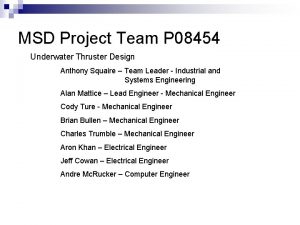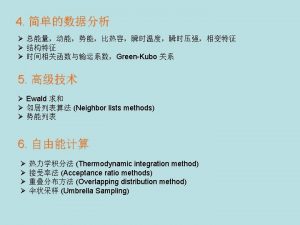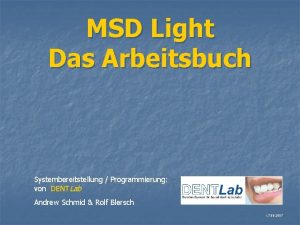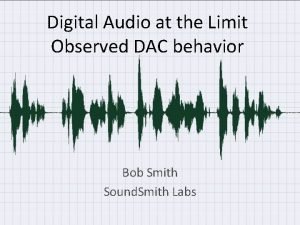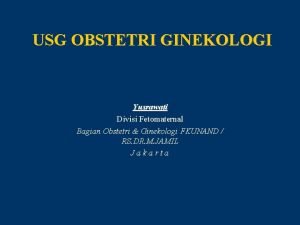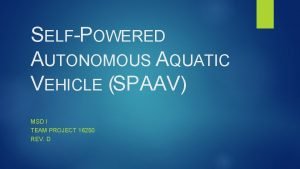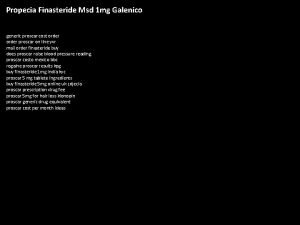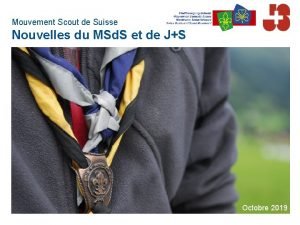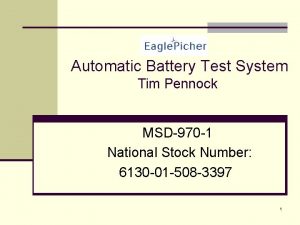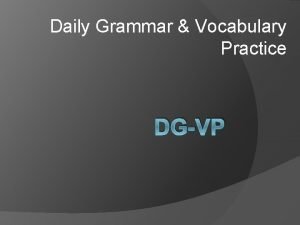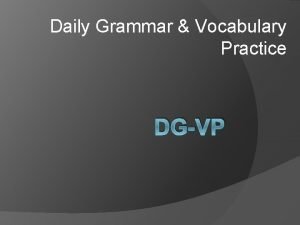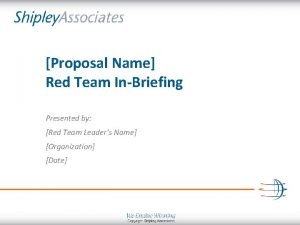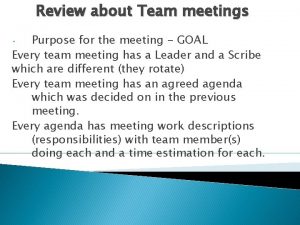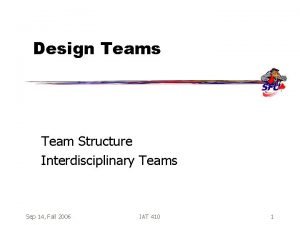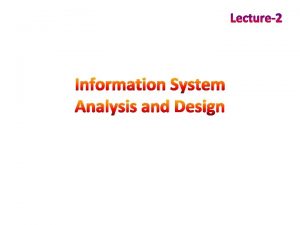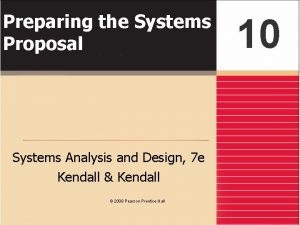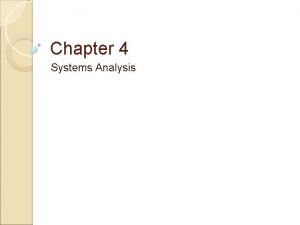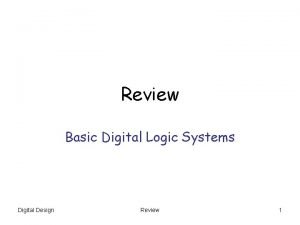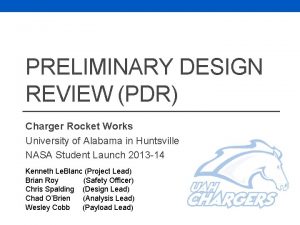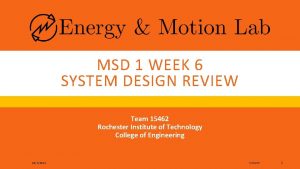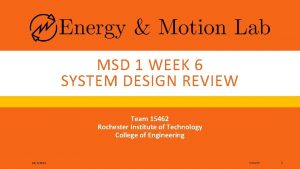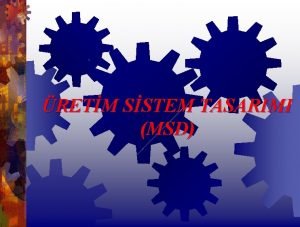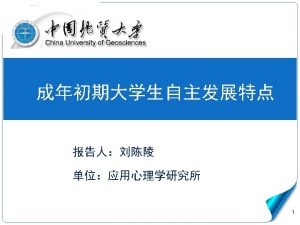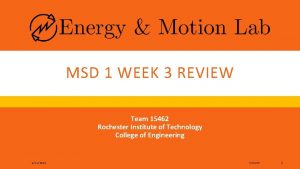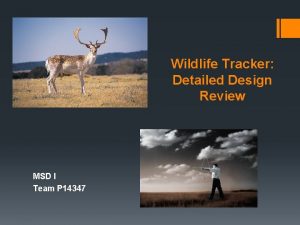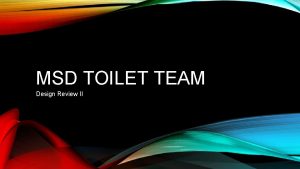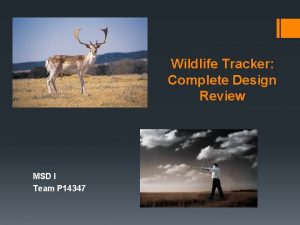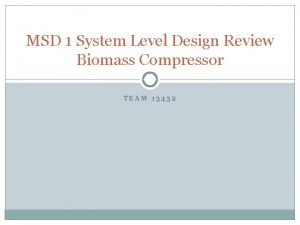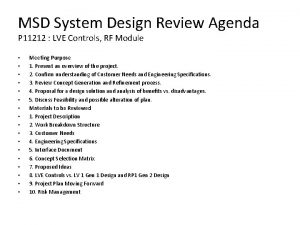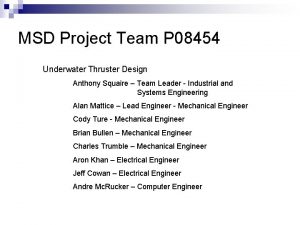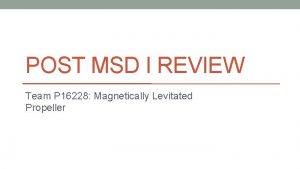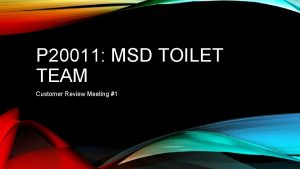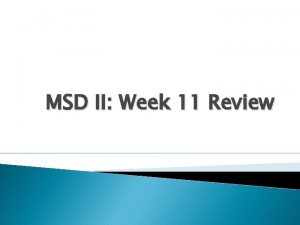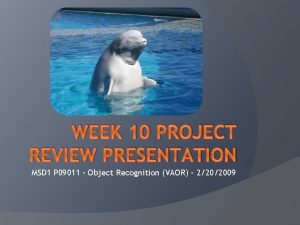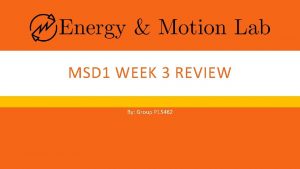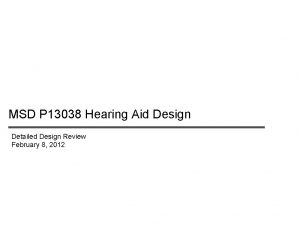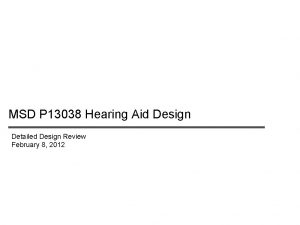MSD 1 WEEK 6 SYSTEM DESIGN REVIEW Team












































- Slides: 44

MSD 1 WEEK 6 SYSTEM DESIGN REVIEW Team 15462 Rochester Institute of Technology College of Engineering 10/2/2014 P 15462 1

AGENDA Background (10 minutes) Problem Statement Customer Needs Engineering Requirements Week 3 action item review 10/2/2014 System Analysis Functional Decomposition Areas of Design Solution Brainstorming Selection Criteria Concept Generation Pugh Chart Final System Selection Concept Feasibility Updated Project Plan System Architecture Risk Assessment P 15462 2

PROBLEM STATEMENT The goal of this project is to design, build, and reliably test an unpowered, human-controlled tethered glider specifically for use as an Airborne Wind Turbine system (AWT). 10/2/2014 100 m 250 m 100 m. P 15462 3 250 m

CUSTOMER NEEDS Customer Need # CN 1 CN 2 CN 3 CN 4 CN 5 CN 6 CN 7 CN 8 CN 9 CN 10 CN 11 CN 12 10/2/2014 Importance Description 9 Tethered glider system (with electric prop assist for launching) that demonstrates at least 3 minutes of continuous circular flight path with taunt tether. 1 Clean appearance 9 Human controlled plane 3 No special flight skill required 9 Use existing base station design 9 Tether tension is measured and recorded during flights 9 Tether direction is measured and recorded during flights 9 Videos with accompanying data files of all flight tests (even ones that don’t work) 9 Able to survive crashes with minor repairs (short downtime) 9 Replaceable Parts 3 Maintenance Guide 9 Design a robust glider which meets the above repair requirements and can be piloted in the cyclical path. 4 P 15462

ENGINEERING REQUIREMENTS Rqmt. # Importance Type Source Engr. Requirement (metric) Unit of Measure Marginal Value Ideal Value Comments/Status Test (Verification) -- 0. 2 0. 05 Calculation & XLFR 5 S 1 9 Aero CN 1 Drag Coefficient S 2 9 Aero CN 1 Lift Coefficient -- 0. 7 1 Calculation & XLFR 5 S 3 3 Aero CN 1 Wingspan ft 3. 3 3 Customer Constraint Tape Measure S 4 3 Aero CN 4 Cooper-Harper Rating -- 3 1 Subjective S 5 3 Aero CN 3 Flight Stability Binary Marginal Complete Static Stability Criteria Calulation & Flight Testing S 6 3 Aero CN 11 Profile of Surface for Airfoil Manufacturing in 0. 1 0. 05 GD&T ASTM Standard S 7 9 Aero CN 1 - 0. 82 0. 9 Calculation S 8 1 Aero CN 1 Fixed Angle of Attack deg 0 3 Protractor S 9 9 Electrical CN 7 Horizontal Potentiometer Recording Binary Marginal Complete Capability Exists (P 14462) Lab. VIEW S 10 9 Electrical CN 7 Vertical Potentiometer Recording Binary Marginal Complete Capability Exists (P 14462) Lab. VIEW S 11 9 Electrical CN 1 Electronics Weight lbs 0. 484 0. 4 Motor not included Scale S 12 9 Financial CN 1 Initial Cost $ 250 200 BOM S 13 3 Financial CN 10 Repair Cost $ 100 50 BOM S 14 9 Mechanical CN 6 Tether Tension lbs 5 23 Capability Exists (P 14462) Lab. VIEW S 15 9 Mechanical CN 1 Mechanical Weight lbs 4 3 Scale S 16 9 Mechanical CN 1 Service Ceiling ft 75 100 FAA Regulation Lab. VIEW S 17 3 Mechanical CN 1 Flight Path Diameter ft 25 50 Lab. VIEW S 18 9 Mechanical CN 1 Maximum Glider Speed mph 30 45 Lab. VIEW 20 16 Caliper Efficiency of Wing S 19 3 Mechanical CN 1 Fuselage Cross Sectional Area in 2 S 20 9 Mechanical CN 9 Fuselage Material Tensile Strength psi CF is ideal material Mat. Web Lookup S 21 9 Mechanical CN 9 Wing Material Tensile Strength psi Foam Mat'l Comparison Mat. Web Lookup S 22 3 Time CN 9 Repair Downtime hour 24 1 Stopwatch S 23 3 Time CN 8 Time Between Flights min 30 5 Stopwatch S 24 3 Time CN 4 Training Flight Hours hour 12 1 Training Documetation Stopwatch 10/2/2014 P 15462 5

ENGINEERING REQUIREMENTS ADDITIONS Rqmt. # Importance Type Source Engr. Requirement (metric) Unit of Measure Marginal Value Ideal Value Comments/Status Test (Verification) S 7 9 Aero CN 1 Efficiency of Wing - 0. 82 0. 9 Calculation S 8 1 Aero CN 1 Fixed Angle of Attack deg 0 3 Protractor S 11 9 Electrical CN 1 Electronics Weight lbs 0. 484 0. 4 Motor not included Scale S 12 9 Financial CN 1 Initial Cost $ 250 200 BOM S 15 9 Mechanical CN 1 Mechanical Weight lbs 4 3 Scale S 19 3 Mechanical CN 1 Fuselage Cross Sectional Area in 2 20 16 Caliper S 20 9 Mechanical CN 9 Fuselage Material Tensile Strength psi CF is ideal material Mat. Web Lookup S 21 9 Mechanical CN 9 Wing Material Tensile Strength psi Foam Mat'l Comparison Mat. Web Lookup S 22 3 Time CN 9 Repair Downtime hour 24 1 Stopwatch S 23 3 Time CN 8 Time Between Flights min 30 5 Stopwatch S 24 3 Time CN 4 Training Flight Hours hour 12 1 Training Documetation Stopwatch 10/2/2014 P 15462 6

GLIDER PURCHASE UMX Radian BNF For use as Practice Tethered Glider Onboard Electronics Included Folding Prop Purchased from E-Flite via Amazon $89. 99 +ship Radio from P 14462 (Professor Kolodziej) Futaba 6 EX-PCM Shipping ETA 10/1/2014 10/2/2014 P 15462 7

GLIDER PURCHASE Wingspan: Overall Length: Flying Weight: Motor Size: Radio: CG (center of gravity): Recommended Battery: Flaps: Approx. Flying Duration: Charger: Assembly Time: Assembly Required: 10/2/2014 28. 7 in (730 mm) 16. 5 in (418 mm) 1. 50 oz (43 g) 8. 5 mm coreless brushed motor 4+ channel transmitter required 1. 22 in (31 mm) back from the leading edge of wing at wing root 1 S 3. 7 V 150 m. Ah 25 C Li. Po No 8 -10 minutes 1 S 300 m. A Li. Po USB Charger Less than 1 Hour Yes P 15462 8

AERO CLUB FLIGHT FAMILIARIZATION VIDEO 10/2/2014 P 15462 9

AGENDA Background Problem Statement Customer Needs Engineering Requirements Week 3 action item review 10/2/2014 System Analysis Functional Decomposition (5 min) Areas of Design (3 min) Solution Brainstorming Selection Criteria Concept Generation Pugh Chart Final System Selection Concept Feasibility Updated Project Plan System Architecture Risk Assessment P 15462 10

FUNCTIONAL DECOMPOSITION 10/2/2014 P 15462 11

FUNCTIONAL DECOMPOSITION Reach Desired Altitude Take-Off Method 10/2/2014 Engage Tether P 15462 12

FUNCTIONAL DECOMPOSITION Sustain Tethered Flight Path Maintain Peak Altitude 10/2/2014 Regulate Tension Cyclical Path P 15462 13

FUNCTIONAL DECOMPOSITION Repeatable Flight Provide Soft Landing 10/2/2014 Easily Replaceable Parts P 15462 14

FUNCTIONAL DECOMPOSITION Record Data 10/2/2014 Respond to on Board Feedback Integrate with Base Station DAQ Capture Video Record Angle Record length Record Tension P 15462 15

10/2/2014 x x x Capture Video x x x Record Tension x x Record Length x x Record Angle x x Respond to feedback Maintain Cyclical Path x x Easily Replaceable Parts Maintain Peak Altitude x x x Soft Landing Engage Tether Fuselage Wings Horizantal Tail Fuselage Material Wing & Tail Material On-Board Electronics (Control Feedback) Take-Off Method Tether-to-Plane Connection Propeller Location Non-Destructively Achieve Tether Tension Flight Path Non-Destructive Landing Base Station Data Collection Program* Regulate Tension Areas of Design Take Off Method FUNCTIONAL DECOMPOSITION VS. AREAS OF DESIGN x x x P 15462 16

AGENDA Background Problem Statement Customer Needs Engineering Requirements Week 3 action item review System Analysis Function Decomposition Areas of Design Solution Brainstorming (2 min) Selection Criteria (2 min) Concept Generation (2 min) Pugh Chart (5 min) 10/2/2014 Final System Selection Concept Feasibility Updated Project Plan System Architecture Risk Assessment P 15462 17

BENCHMARKING Benchmarking Table Ampyx Wing Design Positive dihedral, semi elliptical wing, high fixed angle of attack, flaps Tail Design Fuselage Design Takeoff Landing Maintaining Tension Tether Length (m) Average Kw Creation Large primary T-shaped rudder with small elevators Mildly Aerodynamic/Box Fuselage with Protruding Pitot Tube Mechanical-Electrical winch system Lands on underside of fuselage and wings Constant reeling in and out of figure 8 pattern 300 -600 meters 15 k. W *Image from Ampyx Power 10/2/2014 P 15462 18

SOLUTION BRAINSTORMING (PT. 1) Fuselage Flying Wing Rod Type Football Shaped Cylindrical Shape Wings Swept Back Swept Forward High Dihedral Low Dihedral Horizontal Tail Fuselage Material Wing/Tail Material On-Board Electronics Take-Off Method Canard EPP Wireless Transmission Rocket Engine Rear Tail ROHACELL Foam In-Flight Data Recorder Compressed Air Cylinders H-shape "Other" Foam With Software Winch V-Shape Carbon Fiber Without Software Hydraulic Cylinders Inverted VTear-Drop Shape Oblique Sweep Plastic Coating Spring Loaded Shape Box Frame "Typical" Blended Wing "Typical" Shape Monocoat Throw Glider Lifting Body Other Coating Balloon Launch Linear Chord Variation Fiberglass Kite-Run Launch Elliptical Chord Aluminum Tow with Truck Variation Winglets Plastic VTOL Bi-Wing Wood Tow with RC plane assistance X-Wing Titanium Drop from Tall Tower Magnetic Rail Gun Mid Placement High Placement Propeller Low Placement Powered Wheels Dragon Scales Bottle Rockets Helicopter Propeller Bend Tree and Slingshot Catapult/ Trebuchet Hot Air Balloon Diet Coke and Mentos 10/2/2014 P 15462 19 Zip-line System

SOLUTION BRAINSTORMING (PT. 2) Tether-to-Plane Connection 3 -Point Bridle 2 -Point Bridle 1 -Point Fixed Bridle 1 -Point Slider Ball-in-Socket Screw Propeller Location Flight Path 3 -Point Chuck 1 Tether per Control Surface Horizontal Circle Offset Vertical Circle Figure 8 Mobius Strip Two Tether Ellipse Kite. Gen Flight Path Roller Coaster Rail Spring on Base Station Track Lasso Flight Path Feedback Triggered Rocket Decellerator Kill Propeller Power Open Cargo Bay and Drop Line at Altitude Tether is a Constant Force Spring Velcro End of Tether to Release at Tension Two Tethers Which Trade Off Slack Reverse Zipline 10/2/2014 Front Middle Back Above Centerline Below Centerline Non-Destructively Achieve Tether Tension Hand Spool Automated Spool On Board Spool Spring Decellerator Constant Force Spring Nothing (Jerk at Tension) Non-Destructive Landing Method Parachute Landing Wheels Smooth Bottom Separate Tethered Balloon Reverse Rockets Tripod Inflatable Stunt Pad Corn Field Skis Gas Inflated Balloon Air Bags/ Mars Rover Quadcopter with Drag Net Porous Net Raised Above Ground P 15462 20

SELECTION CRITERIA Simplicity & Effectiveness of Wing Design Safe Landing Initial Cost Development Time Replacement Part Cost Simplicity of Take-Off Method Weight Tether Stress on Plane Durability Tether Impulse Mitigation Ease of Manufacturing 10/2/2014 P 15462 21

CONCEPT GENERATION Area of Design Devin Maginn Kennedy Zebert Carl Fuselage Design Football Shape Tear Shape Cylindrical Box type with nose cone Wing Design Mid, High Dihedral, linear taper Elliptical Wing/ low mount, Asymmetrical Dihedral Linear Taper/Low Dihedral/Flaps Flush transition from fuselage to High dihedral/ linear taper wing/ winglets Horizontal Tail Design H shape Low, Asymmetrical Dihedral Rear Tail/Normal Shape Rear Tail/ Normal Fuselage Material Wood Foam/ Integrate with Fuse Other Foam/Monocoat EPP with CF rod support Carbon-Fibre Wing/Tail Material Foam with Monocoat Yes EPP or better with Monocoat In-Flight Data Recorder with Software Foam On-Board Electronics Other Foam/Monocoat In-Flight Data Recorder with Software Plane Take-Off Method Plane-to-Tether Connection Man-powered winch Prop with hand launch Prop with winch launch Propeller hand launch Spool on Plane/ One Point Propeller with hand launch One Point/Ball and Socket Joint One Point Spool Prop Location 2 Mid Wing Mounted Props Nose Middle (on top of fuselage) Middle Non-Destructively Achieve Tether Tension Spool on Board Spring Behind Base hand spool On-Board Spool Offset Vertical circle Offset vertical circle Infinity shape Parachute Deployment Smooth Bottom Offset Vertical Circle Land on Airframe "Smooth" Flight Path Infinity Protruding Rod/ Smooth Non-Destructive Landing Bottom 10/2/2014 Yes P 15462 22

PUGH CHART Selection Criteria Simplicity/Effectiveness of Wing Design Initial Cost Replacement Part Cost Weight Durability Ease of Manufacturing Safe Landing Develop Time Repair Downtime Simplicity of Take-Off Method Tether Stress on Plane * Tether Impulse Mitigation Sum +'s Sum -'s Sum s's Score 10/2/2014 Maginn + + + s s + Zebert + + + s s Devin + + s + Kennedy + + + s s s Carl + + + s s + Datum (P 14462 Bought Plane) 6 4 2 2 5 5 2 0 5 6 1 -1 5 4 3 1 6 4 2 2 Datum P 15462 23

PUGH CHART Selection Criteria Simplicity/Effectiveness of Wing Design Initial Cost Replacement Part Cost Weight Durability Ease of Manufacturing Safe Landing Develop Time Repair Downtime Simplicity of Take-Off Method Tether Stress on Plane * Tether Impulse Mitigation Sum +'s Sum -'s Sum s's k 10/2/2014 Maginn + + + s - Zebert + + + s s s - Devin + + s s Kennedy s + + + s s + + s - 5 6 1 -1 3 6 3 -3 5 3 4 2 Carl Datum 0 Datum (P 14462 Bought Plane) + + s s 4 6 2 -2 P 15462 24

AGENDA Background Problem Statement Customer Needs Engineering Requirements Week 3 action item review System Analysis Function Decomposition Areas of Design Solution Brainstorming Selection Criteria Concept Generation Pugh Chart Final System Selection (5 min) Concept Feasibility (15 min) Updated Project Plan System Architecture Risk Assessment 10/2/2014 P 15462 25

FINAL SYSTEM SELECTION Areas of Design Final System Fuselage Design Aerodynamically Optimized Rectangular Volume Wing Design Linear Taper, Fixed Angle of Attack, Dihedral, Flaps Horizontal Tail Design H-Shaped Tail Fuselage Material Foam Wing/Tail Material Carbon Fiber Strip Leading Edge, Foam with Coating On-Board Electronics (Control Feedback) In-Flight Data Recorder with Software Plane Take-Off Method Propeller hand launch Plane-to-Tether Connection One Point/Ball and Socket Joint Prop Location Nose Cone with folding Prop Non-Destructively Achieve Tether Tension Hand Spool 10/2/2014 Flight Path Offset Vertical Circle Non-Destructive Landing Land on Airframe "Smooth" P 15462 26

FINAL SYSTEM SELECTION SKETCH 10/2/2014 P 15462 27

CONCEPT FEASIBILITY - FLAP ANALYSIS (1) (2) (3) 10/2/2014 P 15462 28

CONCEPT FEASIBILITY - FLAP ANALYSIS 10/2/2014 P 15462 29

CONCEPT FEASIBILITY - FLAP ANALYSIS 10/2/2014 P 15462 30

CONCEPT FEASIBILITY-WINCH SYSTEM Means of takeoff since propeller alone is insufficient Pros: System has off board source of power Cons: Mechanical-Electrical system is expensive Alternative Method-Man Powered Pros: More affordable Cons: Must exert energy Is it feasible? Yes! The method is called a Towline Launch. 10/2/2014 P 15462 31

FEASIBILITY STUDY: FOAM MATERIAL 10/2/2014 P 15462 32

CONCEPT FEASIBILITY – FOLDING PROPELLER Benefit: • Less drag in unpowered flight • More durable in nose first crash • Interfaces with normal RC components Feasibility Test Plan: 1. Test Flight with purchased glider Due by: 1. Week 9 10/2/2014 P 15462 33

CONCEPT FEASIBILITY – INFINITY FLIGHT PATH Evaluate: • Is this an easier flight path to maintain Feasibility Test Plan: 1. Test Flight with purchased glider 2. Test Flight with tethered purchased glider Due by: 1. Week 9 2. Week 12 *Image from Ampyx Power 10/2/2014 P 15462 34

CONCEPT FEASIBILITY – DIHEDRAL ANALYSIS Definition of Dihedral: The angle between a wing and pitch axis Dihedral Effect Definition: Amount of roll moment produced per degree of sideslip Also influenced by wing sweep, vertical CG Benefits: Higher dihedral angles generate higher roll moments Stabilizes Plane against crosswinds 10/2/2014 P 15462 35

CONCEPT FEASIBILITY – DIHEDRAL ANALYSIS 10/2/2014 P 15462 36

CONCEPT FEASIBILITY – DIHEDRAL ANALYSIS 10/2/2014 P 15462 37

CONCEPT FEASIBILITY – DIHEDRAL ANALYSIS 10/2/2014 P 15462 38

AGENDA Background Underlying Mission Problem Statement & Deliverables Customer Needs & Engineering Requirements Week 3 action item review System Analysis Functional Decomposition Areas of Design Solution Brainstorming Selection Criteria Concept Generation Pugh Chart Final System Selection Concept Feasibility Test Plan Updated Project Plan (2 min) System Architecture (2 min) Risk Assessment (2 min) 10/2/2014 P 15462 39

UPDATED PROJECT PLAN 10/2/2014 P 15462 40

SYSTEM ARCHITECTURE Base Station Glider Fuselage Tether Remote Control Wings Horizontal Tail Vertical Tail Propeller Ailerons Elevators Rudder Motor On-Board Feedback System On Board Control Electronics 10/2/2014 P 15462 41

RISK ASSESSMENT 10/2/2014 P 15462 42

RISK ASSESSMENT (CONT. ) 10/2/2014 P 15462 43

SOURCES Feasibility Study: Foam Material http: //www. rohacell. com/sites/dc/Downloadcenter/Evonik/Product/ROHACELL/product -information/ROHACELL%20 HERO%20 Product%20 Information. pdf http: //www. sonoco. com/User. Files/sonoco/Documents/Tegrant%20 EPP%20 Design%20 G uide%20 April%202012. pdf http: //en. wikipedia. org/wiki/Dihedral_(aeronautics) 10/2/2014 P 15462 44
 Msd basics review
Msd basics review Andre mcrucker
Andre mcrucker Msd bullying
Msd bullying Mean square displacement diffusion coefficient
Mean square displacement diffusion coefficient Msd
Msd Msd menu
Msd menu Mousai msd 192 dac
Mousai msd 192 dac Cp heat exchanger
Cp heat exchanger Foto usg 8 minggu
Foto usg 8 minggu Msd i
Msd i Msd propecia 1mg
Msd propecia 1mg Msd suisse
Msd suisse Tim pennock
Tim pennock Week by week plans for documenting children's development
Week by week plans for documenting children's development Team member of the week
Team member of the week 5 a day language review week 21
5 a day language review week 21 Daily language review week 18 answers
Daily language review week 18 answers Did you see big
Did you see big Daily language review week 14 answer key
Daily language review week 14 answer key Daily language review week 11 answer key
Daily language review week 11 answer key Dgp sentences 7th grade answers
Dgp sentences 7th grade answers Team spirit becomes team infatuation
Team spirit becomes team infatuation Team spirit becomes team infatuation
Team spirit becomes team infatuation The white team cheers for the blue team, just like
The white team cheers for the blue team, just like Red team review
Red team review Team review meeting
Team review meeting Chapter review motion part a vocabulary review answer key
Chapter review motion part a vocabulary review answer key Uncontrollable spending ap gov
Uncontrollable spending ap gov Nader amin-salehi
Nader amin-salehi Prisma diagram example
Prisma diagram example Narrative review vs systematic review
Narrative review vs systematic review Input and output design
Input and output design User interface design in system analysis and design
User interface design in system analysis and design Dialogue design in system analysis and design
Dialogue design in system analysis and design Design team structure
Design team structure Dtux
Dtux Design thinking team
Design thinking team Design thinking team
Design thinking team Characteristics of system analysis and design
Characteristics of system analysis and design System security in system analysis and design
System security in system analysis and design Title proposal for system analysis and design
Title proposal for system analysis and design Feasibility
Feasibility System analysis definition
System analysis definition Digital design
Digital design Preliminary design review example
Preliminary design review example

